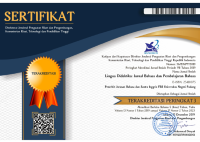SYNTAX ERRORS ON THE ESSAY WRITINGS OF EXTROVERT AND INTROVERT EFL LEARNERS
 ),
), (1) Fakultas Bahasa dan Seni Universitas Negeri Medan Jln. Willem Iskandar Psr. V No. 1589, Medan 20221, Sumatera Utara, Indonesia
 Corresponding Author
Corresponding Author
Copyright (c) 2016 Lingua Didaktika: Jurnal Bahasa dan Pembelajaran Bahasa
DOI : https://doi.org/10.24036/ld.v10i1.6332
Full Text:
 Language : en
Language : en
Abstract
The main purpose of this study was to investigate syntactic errors on extrovert and introvert EFL learners’ essay writing. The data were collected by classification technique from 20 essay writings of EFL learners (10 extroversions and 10 introversions) in Universitas Negeri Medan, Indonesia. The data were analyzed by using X-Bar Theory. The findings of this study indicated that there was a difference between extrovert and introvert in the number of syntax errors. In addition, the extrovert students made 10 types of errors with quantity of 108 while the introvert students only made 8 types of errors with quantity of 60.
Keywords: Writing, Syntax, Extrovert and Introvert.
Keywords
References
Aarts, B. 2001.English syntax and argumentation (2nd Edition) Basingstoke, Hampshire: Macmillan.
Argamon, S., Dhawle, S., Koppel.M., &Pennebaker, J. W. 2005. ‘Lexical predictors of personality type’. In Proceedings of the 2005 Joint Annual Meeting of the Interface and the Classification Society of North America.
Basri D, M., Ampa, A. T. and Junaid. 2013. Syntactic Errors in Descriptive Paragraphs by Native Indonesian-Speaking Students of English. International Journal of Linguistics, 5 (5), 125-137.
Bell, R. T. 1991. Translation and Translating: theory and practice. London: Longman.
Brown, H. D. 2001. Teaching by principles: An interactive approach to language pedagogy. Englewood Cliffs, New Jersey: Prentice Hall Regents.
Brown, H.D. 2000. Principles of language learning and teaching (4th edition). New York: Pearson Longman.
Callahan, S. 2000. Responding to the invisible student.Assessing Writing, 7(1), 57- 77.
Celce-Murcia, M. 2001.Teaching English as a Second or Foreign Language.Third Edition.Heinle: Language Learning.
Chomsky, N. 1965.Aspects of the Theory of Syntax. Cambridge, Mass.: The MIT Press.
Chomsky, N. 1957. Syntactic Structures. The Hague/Paris: Mouton.
Chomsky, N. 1995.The Minimalist Program, MIT Press, Cambridge (Mass.).
Deporter, B. and Heracky. M. 2002. Quantum Learning.Bandung: PenerbitKaifa.
Ellis, R. 2008. The Study of Second Language Acquisition.Oxford: Oxford University Press.
Eysenck, H. J., & Eysenck, M. W. 1985. Personality and individual differences: A natural science approach. New York: Plenum.
Finch, G. 2000. Linguistic Terms and Concepts.New York: St. Martin's Press.
Kiany, G. 1999. Performance on different test methods as a function of extroversion and pedagogical setting. IJALT, 4(1), 37-101.
Koopman, H., Sportiche, D., & Stabler, E. 2013.‘An introduction to syntactic analysis and theory.’Retrieved on April 25, 2014 from books.google.com
Mardijono, J. J. 2003. Indonesian EFL Advanced Learners' Grammatical Errors. Jurnal 'Kata'. 5 (1) 67-90
Nikjoo, N. 1982. Factorial Structure of the EPQ in Iran.Unpublished Ph.D. dissertation, University of Ulster.
Nowson S. 2006. The Language of Weblogs: A study of genre and individual differences. Unpublished Ph.D. thesis, University of Edinburgh.
Sharp, A. 2004. Language learning and awareness of personality type in Chinese settings. Asian EFL Journal, 1, 1-13.
 Article Metrics
Article Metrics
 Abstract Views : 1852 times
Abstract Views : 1852 times
 PDF Downloaded : 608 times
PDF Downloaded : 608 times
Refbacks
- There are currently no refbacks.
Copyright (c) 2016 Lingua Didaktika: Jurnal Bahasa dan Pembelajaran Bahasa









